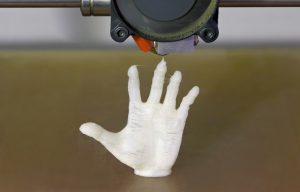With each new year, 3D print technology in the medical field offers greater promise across a wide range of disciplines. While the ultimate goal of printing whole, complex organs for transplants may still be decades away, 3D printing is helping to save and improve lives in ways and places never imagined a generation ago.
 As a matter of fact, Dong-Woo Cho, director of the Intelligent Manufacturing Systems Lab at the Pohang University of Science and Technology in Korea, is working together with his colleagues to apply mechanical engineering know-how to bio-fabrication. They believe that the potential applications for their collaboration include the repair of complex bone and cartilage injuries, along with non-transplant-based treatments for end-stage liver disease.
As a matter of fact, Dong-Woo Cho, director of the Intelligent Manufacturing Systems Lab at the Pohang University of Science and Technology in Korea, is working together with his colleagues to apply mechanical engineering know-how to bio-fabrication. They believe that the potential applications for their collaboration include the repair of complex bone and cartilage injuries, along with non-transplant-based treatments for end-stage liver disease.
The group’s core expertise is 3D printing-related manufacturing technology which involves system design as well as the development of printing processes and software technology. But that’s only part of the picture. “Collaboration with experts in the field of biology and medicine is essential for the application of biofabrication,” Cho comments. “Research on this topic becomes more meaningful when cellular and clinical expertise is reflected in the work.”
Here are just four ways 3D print technology is being used in the medical field:
3D printing labs in hospitals:
“One of the more immediate emerging trends is the use of 3D printing directly in hospitals,” said Dr. Justin Ryan, a biomedical engineer and research scientist at Phoenix Children’s Hospital’s Cardiac 3D Print Lab. “Up until a couple of years ago, there were only a few hospitals doing 3D printing directly in the hospital.”
Across the country, and around the globe, hospitals are setting up 3D printing labs within their facilities so that healthcare professionals can use the process in the normal ebb and flow of the day’s work. In fact, Ryan’s lab has collaborated with over 15 medical facilities in six countries.
Customized medical implants:
Like the work Mr. Cho and his team are perfecting, 3D printed replacements for bony parts hold a promising future. Knees, hips, ankles, parts of the spine, and skull are implanted every year in the thousands. Imagine a day when those parts can be engineered to the precise needs of a patient.
Although this technique is not generally approved by the Food & Drug Administration, some have taken place with emergency clearance from the FDA. For example, one widely publicized was a tracheal splint developed at the University of Michigan for an infant born with a congenitally defective trachea so weak that it collapsed even after conventional treatment. The bioengineering-surgical team used a CT scan of the infant to 3D print a replica of the infant’s anatomy to create a splint to wrap around the weakened trachea. Tissue from the infant’s bronchus was sewn inside the splint. The device was made of a material similar to that for absorbable sutures so that as the child’s trachea repaired itself it would gradually be absorbed.
Low cost prosthetics:
The interest from non-profit organizations is moving the needle forward when it comes to 3D printed patient-specific prosthetics. They can often be produced at low cost for non-profit groups that work with the disabled and veteran groups who otherwise would never have received them.
Looking into the future: organ construction:
Engineering organ tissue is often considered a young field as a modern scientific discipline. It began ramping up toward the end of the last century. Of course, one can trace the origins of tissue engineering back to the mid-1600’s with the identification of cells.
As one can imagine, the delicate workings of these parts must be constructed with the most minute accuracy. A precision lens crafted by the design and manufacturing team at Universe Optics will ensure that every bone, every prosthetic, and in the future, every organ printed using 3D print technology will meet the details of the patient-specific requirements.